|
|
|
SHIPS ARMOURY
![]()
The USS Katana is equipped with all standard security equipment found normally on non civilian Federation Starships, but is also supplemented with extra state of the art and specialised equipment to allow the security personnel aboard the vessel to adapt to the vastly differing situations that a front line Starship such as the USS Katana encounters.
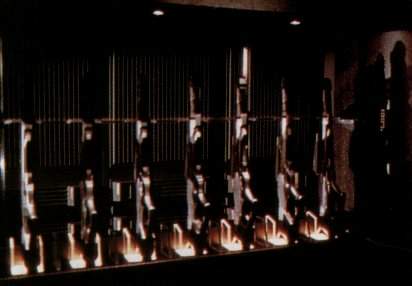
Please note that most information contained within these pages is == under the regulations governing 'military secrets' laid out in the "Starfleet Command Standing Orders". All information unless specifically specified is coded at security level 9, and therefore only authorised personnel may gain access to the information here in.
Ensign John Blaze
Chief of Security
USS Katana NCC-95012
SMALL ARMS - PHASERS
![]()
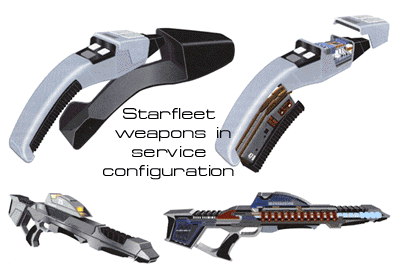
The phaser is the standard Federation beam weapon system. This type of weapon came into common use in 2255, replacing the laser weapons then in service. Phaser is an acronym for PHASed Energy Rectification, a term which referred to the original process by which stored or supplied energy was converted to another form for release toward the target without any need for an intermediate energy transformation. Although this term is something of a holdover, it remains true in modern phaser systems.
Phaser energy is released by the rapid nadion effect. Rapid nadions are short lived subatomic particles which can liberate and transfer strong nuclear forces within a class of crystals called fushigi-no-umi.
Phasers have three distinct effects on the target. At low power settings - setting 1 to 3 on a hand phaser - the impact of phaser energy is almost wholly limited to simple electromagnetic and mild thermal effects. These are concentrated on the nervous system of the target, causing pain and/or unconsciousness in most beings. At higher levels the thermal effect becomes prevalent, and the phaser will begin to cause physical damage to the target resulting in moderate or severe injuries. By the time the power level is at setting 7 the energy is distributed equally between thermal and nuclear disruption energy. Disruption effects become widespread, resulting in immediate death to most Humanoid life forms.
At levels higher than 7 the majority of phaser energy is in the form of nuclear disruption. A large portion of the target is simultaneously vaporized and transported out of the continuum, a process which is instantly fatal. The higher power settings available with Type 3 phasers (setting 9+) cause severe damage over a wide area. These settings are rarely used because of the relatively high power consumption; a single setting 10 discharge uses more than twenty five times as much energy as a setting 7 discharge, while a setting 16 discharge uses over three hundred and fifteen times as much.
TYPE 1 PHASER
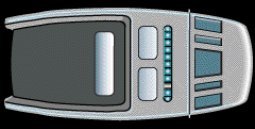
The Type 1 Phaser is a small hand held unit that is approximately the size of a deck of cards. It is capable of firing on a strength of up to setting 8, which causes total vaporization of humanoids, as 50% of the targeted area transitions out of the continuum. All security officers aboard the USS Katana are issued a Type 1 Phaser as standard equipment, and are expected to carry it at all times whilst off duty (SEE SECURITY DEPARTMENT STANDING ORDERS).
TYPE 2 PHASER
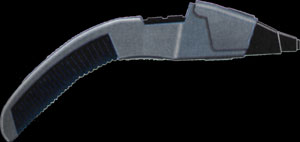
A larger hand unit, the Type 2 Phaser is the standard issue sidearm for security personnel on duty aboard most Federation Starships. Early models of the Type 2 Phaser used a type 1 phaser clipped into a pistol grip, but modern weapons seem to have little in common with the smaller model. The modern type 2 phaser can fire up to setting 16, which can cause the destruction of up to 3,900 metric tons of rock per .28 seconds of discharge.
TYPE 3 PHASER
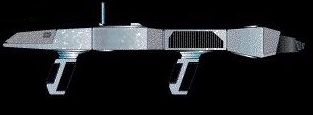
The Type 3 Phaser is a rifle version of the Type 2 Phaser. It uses a nearly identical "business end" as the Type 2
Phaser, and, like the Type 2 Phaser, it is also capable of firing to setting 16. There are a couple of advantages of
the Type 2, being mainly a 50% greater energy reserve, a multiple target acquisition system and a
gyrostabaliser system, giving the user better balance and controll over the weapon, and therefore increasing
accuracy. Recently the standard type 3 phaser rifle has apparently received the same advanced targeting system
as the Heavy Phaser Rifle, otherwise known as the Type 3a Phaser Rifle.
TYPE 3a PHASER RIFLE - or - PULSE RIFLE
 Mk. I - T 3a Phaser
Mk. I - T 3a Phaser
 Mk. II - T 3a Phaser
Mk. II - T 3a Phaser
The Type 3a Phaser, known also as the Pulse Rifle and the Heavy Phaser Rifle, is a much larger, more sophisticated weapon than other Phaser Rifle variants. It is capable of firing phaser energy in either beams or pulses of variable length, therefore giving it better armour penetration abilities or improved multiple foe combat abilities. When the Starfleet design team began work on the Type 3a variant, they decided rather than tamper with the materials that made up the discharge crystal, they built in a small isolinear artificial intelligence unit into the Type 3a which had complete control over energy discharge of the weapon. The design team encountered considerable success in it's testing program that was surprisingly free of difficulties. The use of a computer control system also allows the beam characteristics to be modified much more easily than in previous phaser rifles, which is clearly important when dealing with adaptable foes such as the Borg.
The Type 3a also includes a much more effective and elaborate targeting system, a more powerful gyrostabaliser, and a larger energy reserve, giving the Type 3a excellent assault and defense characteristics, making for an all round excellent sidearm. The Type 3a is capable of firing on a maximum of setting of 18. The targeting unit is now being retro-fitted into earlier models of phaser rifle. The first model of heavy phaser rifle (Mk. I - T3a) had a duranium alloy metal stiffening to the barrel, but in service this has proved to be unnecessary and a subsequent model was issued (Mk. II - T3a) without this feature. The USS Katana employs both variant types of the Type 3a, but is phasing out most of the Mk. I variants, opting instead toward the lighter Mk. II variant.
OTHER SECURITY EQUIPMENT
![]()
COMMUNICATIONS BADGE & MARK X TRICORDER
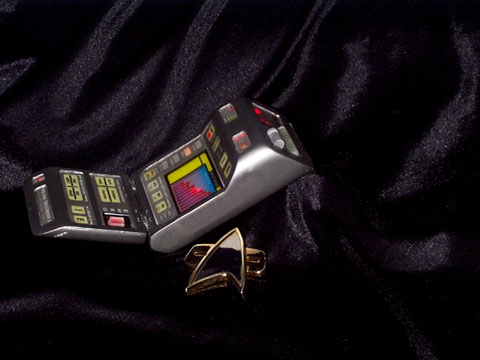
As is the norm with all Starfleet personnel, Security team
members are issued a communications badge. The
communications badges not only allow for easy direct
subspace communication over a great distance, they also
function as a subspace tracking device. That function not
only allows Security to keep a fix on its own, it lets Security
keep track of "friendly targets" during any situation to
assist in rescues & prevent any "friendly fire" incidents.
The tracking function also allows easy lock-on for Security
teams to be beamed site to site throughout the ship to where
needed in an extreme hurry or where obstacles preclude the
use of any other means of entry into a crisis area.
Standard Mark X series tricorders are issued to Security personnel. However, they are then usually reconfigured specifically for locating and/or identifying hostile targets. as well as tracking them (often beyond line of sight), locating and examining forensic evidence on the scene, and also are often modified to double as rudimentary medical tricorders for the administration of basic first aid during combat situations. Some more technically minded Security personnel may configure their tricorders to also function as PADDs or handheld personal computers to enable ready access to ship's systems in their immediate area: For example - force fields, life support, holographic systems, etc. However, such broad configurations can noticeably limit the overall sensitivity of a tricorder and often could require some cumbersome manual resetting of functions in the field. The streamlined and compact folding construction of the Mark X tricorder allows for it to be kept out of the way when not in use inside a snug holster that is usually attached to the uniform at the right side of the hip.
MARK XI PERSONAL BODY ARMOUR (PBA)
= IMAGE CLASSIFIED =
level 12 security clearance required -
Mark XI PBA is designed for a balance of maximum mobility and comfort for the wearer. Designed and tested by the Starfleet special projects and development team, it can protect a wearer from the effects of an energy weapons discharge equivalent to a typical strength 5 Starfleet Phaser.
The PBA consists mainly of rigid front & back panels that are clamped together around the body in a clam style to protect the core of the torso (most common area of vital organs in humanoid species). Optional hinged shoulder units are issued with the main torso unit & can be attached for further protection without hindering movement. Leg & arm units (clam like clamping fit) are also available upon request & superior's approval but can tend to hinder the wearer's flexibility / agility due to the added weight on the limbs & the armor plates disallowing full bending of the joints as the opposing rigid plates come in contact with each other before the particular joint (knee, elbow, ankle, etc.) can bend to its natural limit.
With credit to the miracle of replicator technology, each member of Security is issued one precisely custom fit & comfortably internally padded torso unit with shoulder units. However, the issuing of leg & arm units & spare PBA in general is limited by the extremely complex (& highly classified) duranium/tritanium poly-alloy composition of the armor plating that requires the use of industrial grade replicators & the disproportionate consumption of large amounts of replicator energy-matter matrix reserves. As such, Security tends to use/wear even their custom issued PBAs sparingly, reserving them for extreme emergencies such as during a hostile boarding/takeover of the ship. Usually a stock of 5 generic sized basic PBA units is maintained in each Weapons Locker as either spares for Security or to be distributed to non-Security personnel assigned to supplement Security's operations where personal armor is deemed necessary.